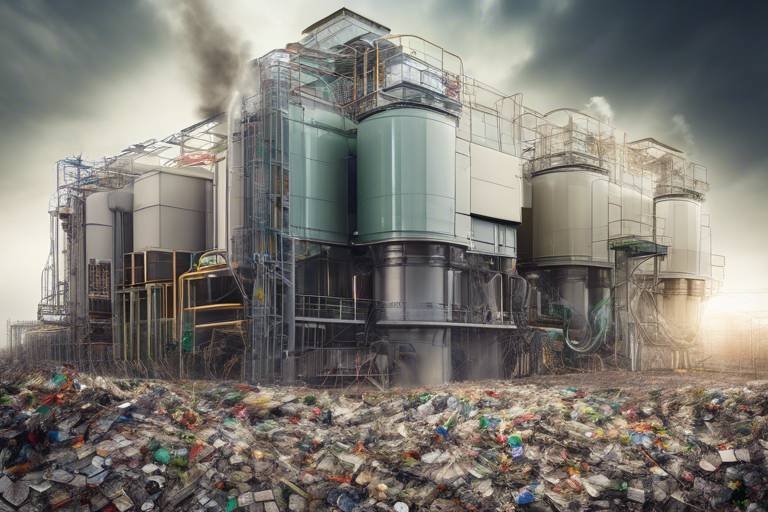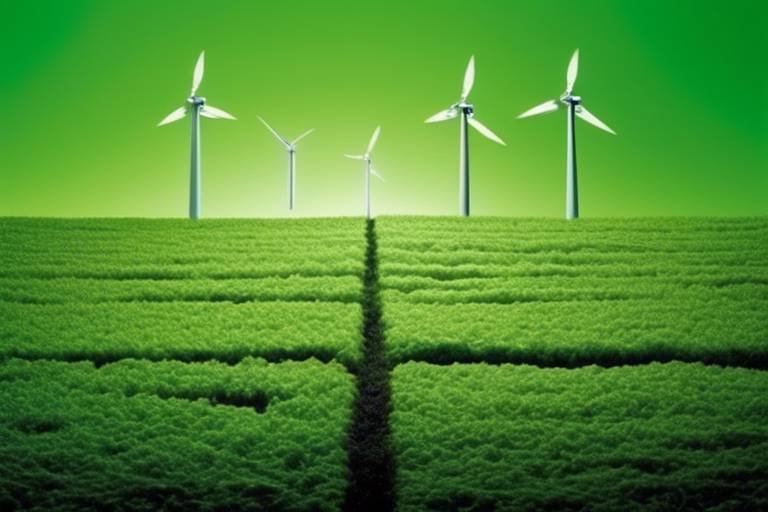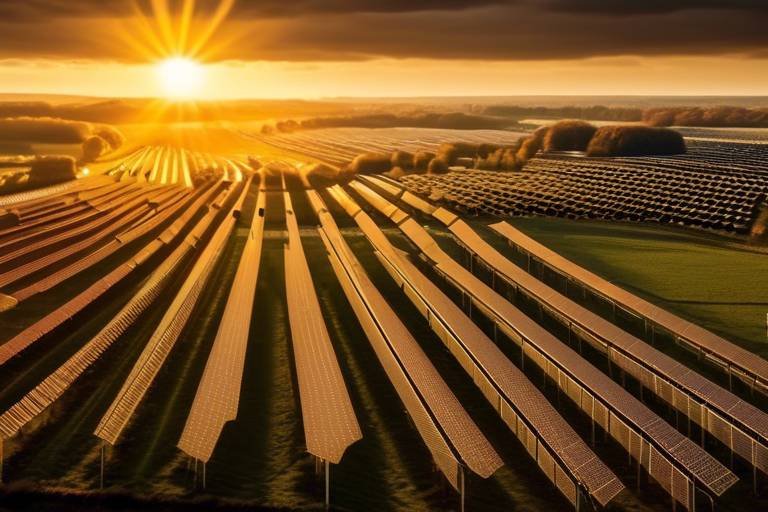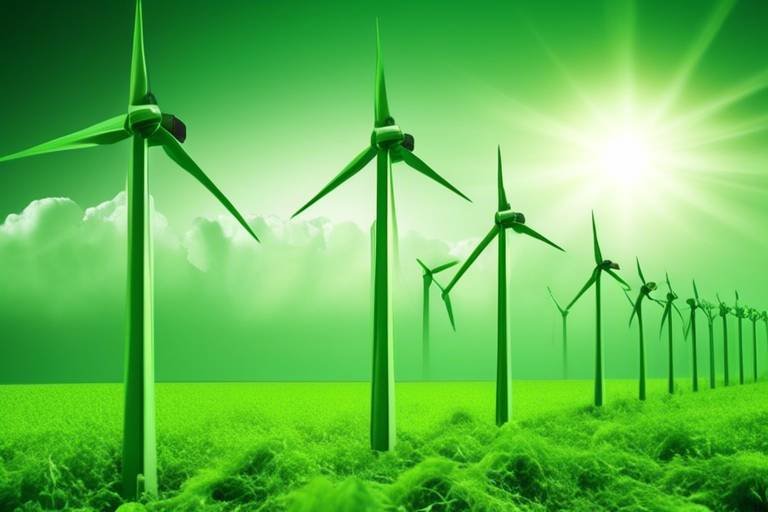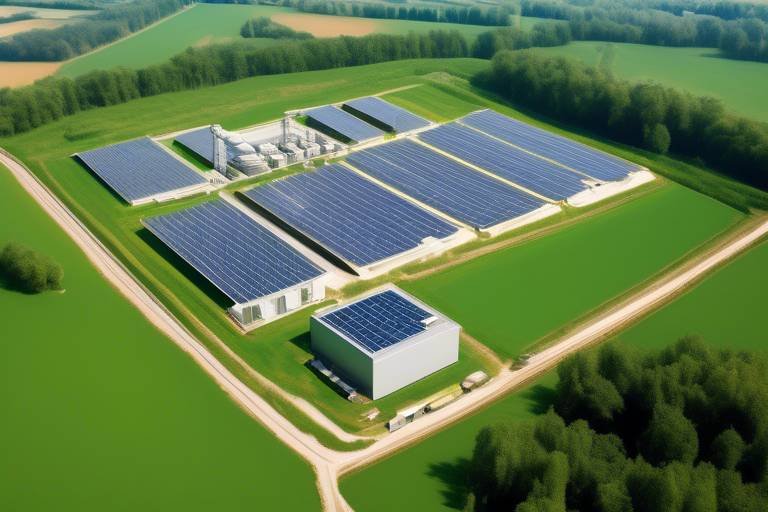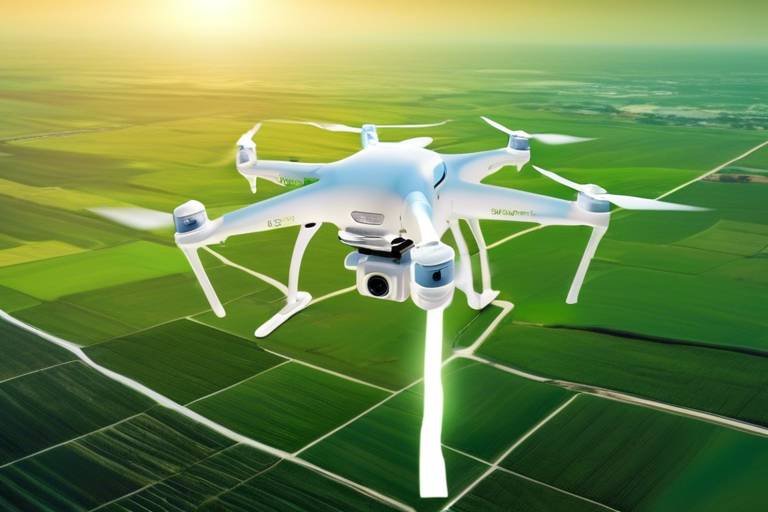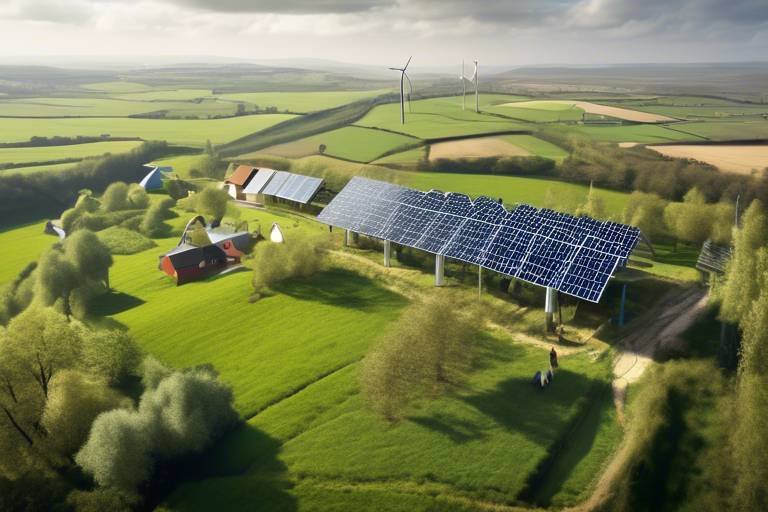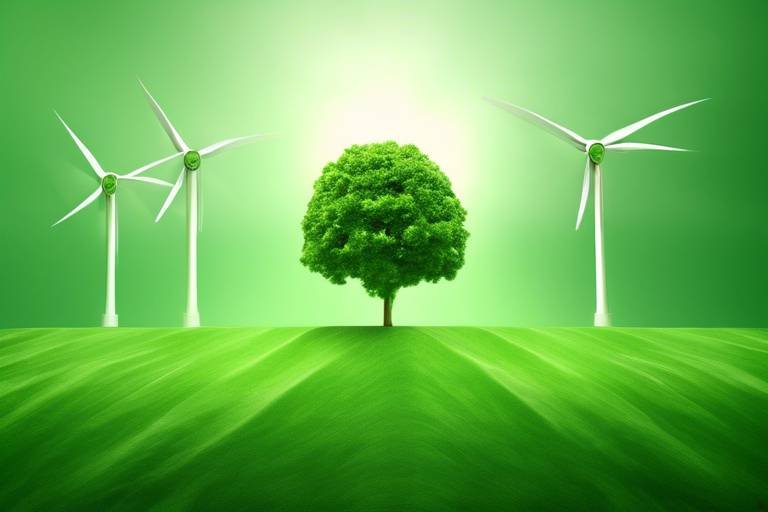Deciphering the Process of Energy Generation from Waste
In today's world, where waste generation is at an all-time high, the concept of converting waste into energy is not just a fleeting trend; it's a necessity. Imagine a world where the trash we throw away becomes a valuable resource, powering our homes and industries. This innovative approach not only addresses the growing waste crisis but also contributes to sustainable energy solutions. In this article, we will explore the various methods of waste-to-energy conversion, the technologies involved, and the environmental impacts of these processes. We'll also take a closer look at how policies shape these initiatives and what the future holds for waste-to-energy solutions.
When we talk about waste-to-energy technologies, we are referring to a variety of methods that transform waste into usable energy. These methods include incineration, anaerobic digestion, and gasification. Each of these technologies operates on different principles and has its unique efficiencies. For instance, incineration involves burning waste at high temperatures to generate heat, which is then converted into electricity. On the other hand, anaerobic digestion uses microorganisms to break down organic waste in the absence of oxygen, producing biogas that can be used for heating or electricity generation. Gasification, meanwhile, converts organic or fossil-based materials into carbon monoxide, hydrogen, and carbon dioxide at high temperatures, which can then be used to produce synthetic gas. Understanding these technologies is crucial as they play a pivotal role in addressing both waste management and energy generation.
While waste-to-energy systems offer innovative solutions, they also come with environmental implications that warrant careful consideration. On one hand, these technologies can significantly reduce the volume of waste sent to landfills, thereby conserving space and reducing methane emissions associated with decomposing waste. On the other hand, the processes can lead to emissions that may affect air quality. For example, incineration can release pollutants if not properly managed. Therefore, it's essential to weigh the benefits against the potential drawbacks. The key lies in implementing stringent regulations and advanced technologies that minimize emissions while maximizing resource recovery. This balance is crucial for promoting sustainability in waste management.
Incineration is one of the most widely used methods of waste-to-energy conversion. The process involves burning waste at high temperatures, which reduces its volume significantly while generating heat that can be converted into electricity. The operational process is relatively straightforward: waste is fed into a furnace where it is combusted, and the heat generated is used to produce steam that drives turbines. However, incineration is not without its concerns. Emissions from the combustion process can include harmful pollutants such as dioxins and furans, which necessitate advanced filtration and scrubbing systems to mitigate their impact on the environment.
Despite the concerns, incineration presents several advantages. It can effectively reduce waste volume by up to 90%, which is a significant benefit in urban areas where landfill space is limited. Additionally, it generates a substantial amount of energy, making it an efficient waste management strategy. Furthermore, modern incineration plants are equipped with advanced emission control technologies that minimize environmental impact, allowing them to operate within regulatory standards.
However, incineration faces challenges, particularly regarding public perception. Many communities are resistant to incineration facilities due to fears about air pollution and health risks. Additionally, regulatory hurdles can complicate the development of new incineration plants. Addressing these challenges requires transparent communication and community involvement in the planning process, as well as ongoing advancements in emission control technologies.
Anaerobic digestion is another fascinating method of waste-to-energy conversion. This biological process involves breaking down organic materials, such as food waste and agricultural residues, by microorganisms in an oxygen-free environment. The result is biogas, a renewable energy source that can be used for heating, electricity generation, or even as a vehicle fuel. The digestate, or leftover material, can be used as a nutrient-rich fertilizer, making anaerobic digestion a sustainable option for both energy production and waste management.
Government policies play a crucial role in shaping the landscape of waste-to-energy projects. Legislation can provide incentives for investment in waste-to-energy technologies, supporting research and development efforts. Additionally, environmental standards ensure that these systems operate within safe limits, protecting public health and the environment. By fostering a supportive regulatory framework, governments can encourage the adoption of waste-to-energy solutions and facilitate the transition towards a more sustainable future.
Looking at international case studies can provide valuable insights into successful waste-to-energy initiatives. For instance, countries like Sweden and Germany have implemented robust waste-to-energy programs that not only manage waste effectively but also generate significant amounts of energy. These examples highlight the diverse approaches that can be taken in different contexts, demonstrating the potential for waste-to-energy solutions to contribute to both energy security and environmental sustainability.
As we look to the future, the potential for waste-to-energy technologies seems promising. Innovations in technology, such as improved gasification methods and enhanced anaerobic digestion processes, could make these systems even more efficient and environmentally friendly. Moreover, public awareness and acceptance of waste-to-energy solutions are crucial for their success. As communities become more informed about the benefits of these technologies, we can expect greater support for waste-to-energy initiatives, paving the way for a cleaner, more sustainable future.
- What is waste-to-energy? Waste-to-energy refers to the process of converting waste materials into usable energy, typically through methods such as incineration, anaerobic digestion, and gasification.
- Is waste-to-energy environmentally friendly? While waste-to-energy can reduce landfill use and generate energy, it is essential to manage emissions properly to minimize environmental impact.
- What types of waste can be converted to energy? Organic waste, plastics, and other combustible materials can typically be processed through various waste-to-energy technologies.
- How does anaerobic digestion work? Anaerobic digestion involves breaking down organic waste by microorganisms in an oxygen-free environment, producing biogas as a renewable energy source.

Understanding Waste-to-Energy Technologies
In our quest for sustainable energy solutions, waste-to-energy technologies are emerging as a beacon of innovation. These technologies transform everyday waste into valuable energy, bridging the gap between waste management and energy production. But how does this fascinating process work? Let’s dive into the main technologies that make this possible, including incineration, anaerobic digestion, and gasification.
First up is incineration, a method that has been around for quite some time. It involves burning waste at high temperatures, which reduces its volume significantly while generating heat. This heat can then be converted into electricity or used for district heating. Imagine a giant furnace where waste is fed in one end, and out comes energy! However, it's not all sunshine and rainbows; the process does produce emissions that need to be carefully controlled.
Next, we have anaerobic digestion, a biological process that breaks down organic waste in the absence of oxygen. This method is particularly effective for food waste and agricultural residues. During digestion, microorganisms decompose the waste, producing biogas—a mixture of methane and carbon dioxide. This biogas can be harnessed to generate electricity or heat, or even upgraded to biomethane for use as a vehicle fuel. It’s like giving waste a second life, turning what would be garbage into a clean energy source!
Then there's gasification, a more advanced technology that converts organic or fossil-based materials into carbon monoxide, hydrogen, and carbon dioxide through high-temperature processing with a controlled amount of oxygen. This process results in a synthetic gas, or synthesis gas, which can be used to produce electricity, fuels, and chemicals. Picture a high-tech lab where waste is transformed into a gas that powers our cars and homes!
Each of these technologies has its own unique mechanisms and efficiencies, making them suitable for different types of waste and energy needs. To give you a clearer picture, here’s a quick comparison of these three methods:
| Technology | Process | Main Products | Environmental Impact |
|---|---|---|---|
| Incineration | Burning waste at high temperatures | Heat, Electricity | Emissions control needed |
| Anaerobic Digestion | Biological breakdown of organic waste | Biogas (methane) | Low emissions, nutrient recovery |
| Gasification | High-temperature conversion with limited oxygen | Synthesis gas | Lower emissions compared to incineration |
Understanding these technologies is crucial for recognizing their potential in addressing waste management challenges and contributing to a more sustainable future. With the right policies and public support, waste-to-energy technologies could play a significant role in our energy landscape, turning trash into treasure.

The Environmental Impact of Waste-to-Energy
When we think about the relationship between waste and energy, it’s easy to overlook the environmental implications of such technologies. Waste-to-energy (WtE) systems have emerged as a solution that not only tackles the growing issue of waste disposal but also provides a source of renewable energy. However, like any innovative solution, they come with their own set of environmental impacts, both positive and negative. It's essential to dive into these implications to understand how WtE can contribute to a more sustainable future.
One of the most significant benefits of waste-to-energy technologies is their ability to reduce landfill waste. Traditional waste management often leads to overflowing landfills, which can cause soil and groundwater contamination. In contrast, WtE facilities can significantly decrease the volume of waste that ends up in landfills. For instance, incineration can reduce waste volume by up to 90%, effectively minimizing the space required for waste disposal.
Moreover, WtE technologies can produce renewable energy in the form of electricity and heat. This energy can be harnessed to power homes and industries, thereby decreasing reliance on fossil fuels. The recovery of energy from waste not only supports energy diversification but also contributes to a reduction in greenhouse gas emissions, as less waste in landfills means less methane production—a potent greenhouse gas.
However, it’s crucial to consider the potential drawbacks of waste-to-energy systems. For instance, the incineration process can release toxic emissions, including dioxins and heavy metals, if not properly managed. These emissions can pose a risk to air quality and public health. Therefore, advanced emission control technologies must be implemented to mitigate these risks. The table below outlines the main emissions associated with incineration and their potential impacts:
| Emission Type | Potential Impact |
|---|---|
| Dioxins | Can cause cancer and disrupt hormonal systems |
| Heavy Metals | Toxic to humans and wildlife, can accumulate in the food chain |
| Particulate Matter | Can lead to respiratory problems |
| Carbon Dioxide | Contributes to climate change |
Another environmental concern is the resource recovery aspect of waste-to-energy processes. While WtE can generate energy, it can also lead to the loss of valuable materials that could have been recycled. The focus should not only be on energy recovery but also on maximizing material recovery. This dual approach can significantly enhance the sustainability of waste management strategies.
In conclusion, the environmental impact of waste-to-energy systems is a complex interplay of benefits and challenges. While they present an innovative solution to waste management and energy production, careful consideration must be given to emissions and resource recovery. As technology advances and public awareness grows, the potential for waste-to-energy solutions to contribute positively to our environment becomes increasingly viable.
- What is waste-to-energy? Waste-to-energy is a process that converts waste materials into usable forms of energy, such as electricity or heat.
- Are waste-to-energy plants environmentally friendly? They can be environmentally friendly if equipped with proper emission control technologies and if they effectively reduce waste volumes.
- What types of waste can be used for energy generation? Organic waste, plastics, and certain industrial wastes are commonly used in waste-to-energy processes.
- How does waste-to-energy help reduce landfill usage? By converting waste into energy, WtE facilities significantly decrease the volume of waste that would otherwise occupy landfills.

Incineration: A Common Method
Incineration stands out as one of the most widely recognized methods of converting waste into energy. At its core, this process involves the combustion of organic materials, which generates heat that can be transformed into electricity or used for heating purposes. Imagine a giant furnace, where waste is not just thrown away but is instead harnessed to produce energy—this is the essence of incineration. But how does it work? The waste is fed into a combustion chamber, where it is ignited at high temperatures, often exceeding 850 degrees Celsius. The heat produced not only reduces the volume of waste significantly but also drives turbines to generate electricity.
One of the significant advantages of incineration is its efficiency in waste management. According to studies, incineration can reduce the volume of waste by up to 90%, which is a game-changer for landfills that are quickly reaching capacity. However, it’s essential to note that while incineration offers a solution to waste disposal, it also raises concerns regarding emissions. The combustion process can release pollutants such as dioxins, furans, and particulate matter into the atmosphere. Therefore, modern incineration facilities are equipped with advanced emission control technologies to mitigate these risks. The table below outlines the operational process of incineration and its energy recovery rates:
| Stage | Description | Energy Recovery Rate |
|---|---|---|
| Waste Feeding | Waste is loaded into the combustion chamber. | N/A |
| Combustion | Waste is burned at high temperatures. | Up to 25% of energy content can be recovered. |
| Heat Recovery | Heat generated is used to produce steam. | Can generate electricity through turbines. |
| Emission Control | Advanced systems filter out harmful pollutants. | N/A |
Despite its operational efficiency, incineration faces several challenges. Public perception often leans towards negativity, fueled by fears of air pollution and health risks. Communities may resist the establishment of incineration plants, fearing that they will lead to increased emissions in their neighborhoods. Additionally, regulatory hurdles can complicate the development of new facilities. Stricter environmental regulations mean that companies must invest heavily in emission control technologies, which can raise the cost of building and operating incinerators. This brings us to the question: how do we balance the need for energy production with environmental safety?
Ultimately, incineration is a double-edged sword. It reduces waste and generates energy, but it also poses environmental challenges that cannot be overlooked. As technology advances, the hope is that incineration can become a cleaner, more efficient method of waste-to-energy conversion, paving the way for a more sustainable future.
- What types of waste can be incinerated? Most organic waste, including municipal solid waste, can be incinerated, but hazardous materials should be treated differently.
- How does incineration compare to landfilling? Incineration significantly reduces waste volume and can generate energy, whereas landfilling simply stores waste.
- Are there health risks associated with incineration? While modern incinerators are equipped to minimize emissions, concerns about air quality persist, necessitating strict regulations.

Advantages of Incineration
When it comes to waste management, incineration often stands out as a powerful solution, and for good reason. Imagine a process that not only reduces the volume of waste but also transforms it into usable energy. Sounds like a win-win, right? One of the primary advantages of incineration is its ability to significantly decrease the amount of waste that ends up in landfills. In fact, incineration can reduce waste volume by up to 90%, making it a truly effective method for managing our overflowing landfills.
Moreover, incineration generates energy in the form of electricity and heat. This energy can be harnessed to power homes and businesses, contributing to a more sustainable energy grid. In a world where energy demands are constantly rising, the ability to convert waste into energy could be a game changer. For instance, many modern incineration plants are designed to capture and utilize the heat produced during the combustion process, which can be used for district heating systems or to generate electricity through steam turbines.
Another significant advantage is the reduction of harmful substances. While some may argue that incineration releases emissions, advancements in technology have led to the development of sophisticated emission control systems. These systems are designed to capture and filter out harmful pollutants, ensuring that the air quality remains within safe limits. In fact, many modern incinerators are equipped with scrubbers and filters that can remove up to 99% of particulate matter and other harmful substances from the emissions.
In addition to energy recovery and pollution control, incineration also plays a crucial role in resource recovery. Some incineration facilities are equipped to extract valuable metals from the ash produced during the combustion process. This not only helps in recycling materials but also reduces the need for mining new resources, which can be environmentally damaging.
To sum it up, the advantages of incineration can be highlighted as follows:
- Significant reduction in waste volume - Up to 90% reduction, easing landfill pressure.
- Energy generation - Produces electricity and heat, contributing to energy sustainability.
- Advanced emission control - Modern technology minimizes harmful pollutants.
- Resource recovery - Potential to recycle metals from incineration ash.
With these benefits in mind, it's clear that incineration is more than just a waste disposal method; it’s a multifaceted approach to managing our waste while simultaneously addressing energy needs. As we continue to innovate and improve the technologies involved in incineration, we may find ourselves with a more sustainable and efficient waste management system that not only tackles the problem of waste but also contributes positively to our energy landscape.
Q1: Is incineration safe for the environment?
A1: Yes, when equipped with modern emission control technologies, incineration can be a safe method of waste disposal that minimizes harmful emissions.
Q2: What types of waste can be incinerated?
A2: Most municipal solid waste, including organic materials, plastics, and paper, can be incinerated. However, hazardous waste requires special handling and should only be processed in facilities designed for that purpose.
Q3: How does incineration compare to landfilling?
A3: Incineration reduces waste volume significantly and generates energy, while landfilling typically results in a larger accumulation of waste over time without energy recovery.
Q4: Can incineration contribute to climate change?
A4: While incineration does produce emissions, the energy generated can replace fossil fuels, potentially reducing overall greenhouse gas emissions when managed properly.

Challenges of Incineration
While incineration is often heralded as a viable solution for waste-to-energy conversion, it is not without its challenges. One of the primary hurdles is public perception. Many communities are apprehensive about having incineration facilities in their vicinity, fearing potential health risks and environmental degradation. This skepticism can lead to significant opposition during the planning and approval stages of projects, making it crucial for proponents of incineration to engage in transparent communication and community outreach.
Another challenge lies in the regulatory landscape. Incineration facilities must comply with a myriad of environmental regulations, which vary widely by region. These regulations often dictate stringent emissions standards, necessitating the use of advanced technology to control pollutants. This can result in increased operational costs, which may deter investment in new incineration projects or upgrades to existing facilities.
Moreover, the technological aspect cannot be overlooked. While modern incinerators are designed to minimize emissions, the technology is not foolproof. Particulate matter, dioxins, and heavy metals can still be released into the atmosphere, raising concerns about air quality and public health. The need for continuous monitoring and maintenance of emission control systems adds another layer of complexity to the operation of incineration plants.
Finally, there is the issue of waste composition. Not all waste is suitable for incineration, and the presence of certain materials can complicate the process. For instance, plastics and other non-combustible materials can lead to operational inefficiencies and increase the amount of residual ash that must be managed. This necessitates a robust waste sorting and management strategy to ensure that only appropriate materials are processed.
In summary, while incineration presents a compelling option for waste-to-energy conversion, it faces significant challenges that must be addressed. From public perception and regulatory hurdles to technological limitations and waste composition issues, overcoming these obstacles is essential for the successful implementation of incineration as a sustainable waste management solution.
- What are the main environmental concerns associated with incineration? Incineration can release harmful emissions, including dioxins and particulate matter, which may impact air quality and public health.
- How does public perception affect incineration projects? Communities often fear potential health risks and environmental impacts, leading to opposition against proposed incineration facilities.
- What types of waste are suitable for incineration? Generally, non-recyclable and combustible waste is suitable, but materials like plastics can complicate the process.
- What technologies are used to control emissions from incinerators? Advanced filtration and scrubber systems are employed to minimize emissions and meet regulatory standards.

Anaerobic Digestion Explained
Anaerobic digestion is a fascinating biological process that transforms organic waste into valuable energy. Imagine a mini ecosystem where microorganisms thrive in the absence of oxygen, breaking down complex organic materials like food scraps, agricultural residues, and even manure. This process not only generates energy in the form of biogas but also produces digestate, a nutrient-rich byproduct that can be used as fertilizer. It's like turning trash into treasure!
The heart of anaerobic digestion lies in its stages, which can be broadly classified into four key phases: hydrolysis, acidogenesis, acetogenesis, and methanogenesis. Each of these stages plays a critical role in breaking down organic matter:
- Hydrolysis: This is the initial stage where complex organic materials are broken down into simpler sugars, amino acids, and fatty acids through the action of enzymes.
- Acidogenesis: In this phase, the simple compounds produced during hydrolysis are further converted into volatile fatty acids, hydrogen, and carbon dioxide by acidogenic bacteria.
- Acetogenesis: Here, the volatile fatty acids are transformed into acetic acid, along with additional hydrogen and carbon dioxide, setting the stage for the final phase.
- Methanogenesis: This is where the magic happens! Methanogenic archaea convert the acetic acid and hydrogen into methane and carbon dioxide, producing the biogas that can be harnessed for energy.
The efficiency of anaerobic digestion can vary based on several factors, including the type of waste being processed, temperature, and retention time. Generally, it operates best with a balanced mix of carbon-rich and nitrogen-rich materials. For instance, kitchen waste, crop residues, and livestock manure are all excellent candidates for anaerobic digestion.
One of the standout features of anaerobic digestion is its dual benefit: it helps in waste management while generating renewable energy. The biogas produced can be used for various applications, such as electricity generation, heating, or even as a vehicle fuel. Furthermore, the digestate can be utilized to enrich soil, promoting sustainable agricultural practices. This circular economy approach not only reduces landfill waste but also mitigates greenhouse gas emissions, making it an environmentally friendly solution.
However, like any technology, anaerobic digestion comes with its own set of challenges. The initial setup costs can be significant, and the technology requires careful management to maintain optimal conditions for microbial activity. Additionally, public awareness and acceptance are crucial for the success of anaerobic digestion projects, as misconceptions about the process can hinder progress.
In conclusion, anaerobic digestion represents a promising avenue for turning organic waste into renewable energy. As we continue to seek sustainable solutions to our waste management challenges, understanding and promoting technologies like anaerobic digestion will be essential. By harnessing the power of nature's recyclers, we can pave the way for a cleaner, greener future.
Q1: What types of waste can be processed through anaerobic digestion?
A1: Anaerobic digestion can process a variety of organic materials, including food waste, agricultural residues, livestock manure, and even some industrial waste. The key is to ensure a balanced mix of carbon and nitrogen-rich materials for optimal digestion.
Q2: What is biogas and how is it used?
A2: Biogas is a mixture of methane and carbon dioxide produced during anaerobic digestion. It can be used for generating electricity, heating, or as a renewable vehicle fuel. It's a clean energy source that helps reduce reliance on fossil fuels.
Q3: Are there any environmental benefits to anaerobic digestion?
A3: Yes! Anaerobic digestion helps reduce landfill waste, lowers greenhouse gas emissions, and produces nutrient-rich digestate that can enhance soil health. It's a win-win for waste management and environmental sustainability.

The Role of Policy in Waste-to-Energy
When it comes to transforming waste into energy, the role of policy cannot be overstated. Government regulations and incentives shape the landscape of waste-to-energy projects, influencing everything from funding availability to environmental standards. Policies can either propel these initiatives forward or create significant roadblocks, making it crucial for stakeholders to understand the regulatory environment in which they operate.
For instance, many countries have implemented renewable energy mandates that encourage the development of waste-to-energy facilities. These mandates often include specific targets for energy generation from renewable sources, which can include biomass and waste materials. By setting these targets, governments create a framework that fosters innovation and investment in waste-to-energy technologies.
Moreover, financial incentives such as tax credits, grants, and subsidies play a pivotal role in making waste-to-energy projects viable. These incentives can significantly lower the initial investment required for construction and operation, thus attracting private investors and public-private partnerships. In many cases, these financial supports are essential for overcoming the high upfront costs associated with advanced waste processing technologies.
However, policies are not without their challenges. Regulatory hurdles can pose significant barriers to the establishment of waste-to-energy facilities. For example, stringent environmental assessments and lengthy permitting processes can delay projects, sometimes for years. This can be frustrating for developers who are eager to bring their innovations to market. Additionally, public opposition to waste-to-energy projects often stems from concerns about emissions and health impacts, which can be exacerbated by insufficient communication from policymakers.
To navigate these complexities, it’s essential for policymakers to engage with the community and stakeholders early in the planning process. This engagement can help build public trust and ensure that the benefits of waste-to-energy projects are clearly communicated. A transparent approach can alleviate concerns and foster a collaborative environment for project development.
In summary, the role of policy in waste-to-energy is multifaceted, encompassing regulatory frameworks, financial incentives, and community engagement. As we move towards a more sustainable future, it’s imperative that policymakers strike a balance between encouraging innovation and ensuring environmental protection. Only through thoughtful, inclusive policy-making can we unlock the full potential of waste-to-energy solutions.
- What are the key policies that support waste-to-energy projects?
Key policies often include renewable energy mandates, financial incentives like tax credits, and environmental regulations that guide project development.
- How do financial incentives impact waste-to-energy initiatives?
Financial incentives help reduce the initial costs of projects, making them more attractive to investors and increasing the likelihood of successful implementation.
- What challenges do waste-to-energy projects face from a policy perspective?
Challenges include regulatory hurdles, lengthy permitting processes, and public opposition, often due to concerns about emissions and health impacts.

Global Case Studies
When it comes to waste-to-energy initiatives, looking at global case studies can provide valuable insights into the effectiveness and adaptability of various technologies. Countries around the world are innovating in this field, each with unique approaches that reflect their specific waste management challenges and energy needs. For instance, Sweden has become a beacon of success in waste-to-energy conversion, boasting a system where nearly 99% of its waste is recycled or converted to energy. This remarkable achievement is largely due to the country's extensive incineration facilities, which not only reduce waste volume but also generate significant amounts of electricity and district heating.
Another fascinating case is found in Germany, where the concept of anaerobic digestion has taken root. Here, organic waste from farms and food production is transformed into biogas, which is then used to generate electricity. This method not only reduces landfill waste but also creates a renewable energy source that can power homes and businesses. The German government has supported this initiative through subsidies and incentives, making it a model for other nations.
In Asia, Singapore has also made strides in waste-to-energy technology. The country has implemented advanced incineration plants that are equipped with state-of-the-art emission control systems. These facilities convert a substantial portion of Singapore's waste into energy while ensuring that emissions remain well within regulatory limits. This is a prime example of how technology can be harnessed to balance waste management and environmental protection.
Moreover, the United States is witnessing a growing interest in waste-to-energy projects, particularly in states like California. Here, innovative solutions such as gasification are being explored. Gasification involves converting organic materials into synthetic gas, which can then be used to produce electricity. This method is still in its nascent stages compared to more established technologies, but its potential to reduce greenhouse gas emissions makes it a promising avenue for future development.
To further illustrate the diversity and effectiveness of waste-to-energy initiatives globally, the following table summarizes key case studies:
| Country | Technology Used | Key Achievements |
|---|---|---|
| Sweden | Incineration | 99% waste recycling; significant energy generation |
| Germany | Anaerobic Digestion | Renewable energy from organic waste |
| Singapore | Advanced Incineration | High efficiency with low emissions |
| USA (California) | Gasification | Emerging technology with potential for low emissions |
These case studies highlight how various countries are not only tackling waste management issues but also contributing to energy generation in sustainable ways. Each nation brings its unique challenges and solutions to the table, showcasing that waste-to-energy technologies can be tailored to fit local contexts. As we look to the future, these examples serve as a blueprint for how innovative thinking can turn waste into a valuable resource, paving the way for a more sustainable world.
What is waste-to-energy?
Waste-to-energy is the process of generating energy in the form of electricity or heat from the treatment of waste. This can involve various technologies, including incineration, anaerobic digestion, and gasification.
How does incineration work?
Incineration involves burning waste at high temperatures to reduce its volume and generate energy. The heat produced can be used to produce steam, which drives turbines to generate electricity.
Are there environmental concerns with waste-to-energy?
Yes, while waste-to-energy can reduce landfill use and generate energy, there are concerns about emissions. Advanced technologies and regulations are crucial to minimize the environmental impact.
Can all types of waste be converted to energy?
Not all waste is suitable for energy conversion. Organic waste is often ideal for anaerobic digestion, while other materials may be better suited for incineration or gasification.
What is the future of waste-to-energy?
The future of waste-to-energy looks promising with ongoing innovations and increased public awareness. As technology advances, we can expect more efficient and environmentally friendly solutions to emerge.

The Future of Waste-to-Energy
The future of waste-to-energy (WtE) technologies is not just bright; it’s positively glowing with potential! As we march towards a more sustainable world, the need for innovative solutions to manage waste while generating energy is becoming increasingly critical. Imagine a world where the trash we toss out becomes a valuable resource, powering our homes and businesses. This transformation is already underway, and it’s fueled by advancements in technology, changing public perceptions, and supportive policies.
One of the most exciting aspects of the future of WtE is the development of next-generation technologies. These innovations promise to enhance the efficiency and effectiveness of converting waste into energy. For instance, researchers are exploring advanced gasification techniques that can convert organic materials into syngas, a clean fuel that can be used for electricity generation or as a feedstock for producing chemicals. This method not only reduces the volume of waste but also minimizes harmful emissions compared to traditional incineration methods.
Moreover, the integration of artificial intelligence (AI) and machine learning into waste management systems is set to revolutionize how we handle waste. By optimizing collection routes and improving sorting processes, AI can increase the amount of waste that is diverted from landfills and directed towards energy recovery facilities. This not only enhances operational efficiency but also maximizes the potential energy output from waste materials.
Public awareness and acceptance are also playing crucial roles in the future of WtE. As communities become more informed about the benefits of waste-to-energy systems, including their potential to reduce landfill waste and lower greenhouse gas emissions, we are likely to see increased support for these initiatives. Education campaigns can help demystify the technology and address common misconceptions, paving the way for more projects to be developed.
Policy frameworks will also be essential in shaping the future landscape of WtE. Governments around the globe are beginning to recognize the importance of waste-to-energy as part of their sustainability agendas. By implementing incentives for WtE projects, providing funding for research and development, and establishing clear environmental standards, policymakers can create an environment that fosters innovation and investment in this sector. For example, countries like Sweden and Germany have already set the bar high by integrating WtE into their national waste management strategies, showcasing how effective policies can lead to successful implementations.
As we look ahead, it’s crucial to consider the potential challenges that may arise. While the technology is advancing, issues such as public opposition, regulatory hurdles, and the need for ongoing investment in infrastructure remain. However, with a concerted effort from all stakeholders—governments, private sectors, and communities—the vision of a sustainable waste-to-energy future can become a reality.
In summary, the future of waste-to-energy is an exciting frontier filled with possibilities. By embracing technology, fostering public support, and implementing sound policies, we can transform waste from a burden into a resource, paving the way for a cleaner, greener planet. The journey towards sustainability is not just a destination; it’s an adventure we must embark on together!
- What is waste-to-energy? Waste-to-energy refers to the process of generating energy in the form of electricity or heat from the treatment of waste.
- How does waste-to-energy benefit the environment? It reduces the amount of waste sent to landfills, decreases greenhouse gas emissions, and provides a renewable energy source.
- What technologies are commonly used in waste-to-energy? Common technologies include incineration, anaerobic digestion, and gasification.
- Are there any drawbacks to waste-to-energy? Yes, potential drawbacks include emissions from incineration and the need for advanced technologies to minimize environmental impact.
Frequently Asked Questions
- What is waste-to-energy?
Waste-to-energy is a process that converts non-recyclable waste materials into usable forms of energy, such as electricity, heat, or fuel. This innovative approach not only helps manage waste effectively but also reduces reliance on fossil fuels, making it a win-win for both the environment and energy production.
- How does incineration work in waste-to-energy?
Incineration involves burning waste at high temperatures, which reduces its volume significantly while generating heat. This heat is then used to produce steam that drives turbines to generate electricity. While effective, incineration does raise concerns regarding emissions, which require advanced filtering systems to mitigate.
- What are the benefits of anaerobic digestion?
Anaerobic digestion is a natural process where microorganisms break down organic matter in the absence of oxygen. This method not only reduces waste volume but also produces biogas, a renewable energy source that can be used for heating or electricity generation. Plus, the digestate produced can be used as a nutrient-rich fertilizer!
- What environmental impacts should I be aware of?
While waste-to-energy technologies can significantly reduce landfill use and generate energy, they also come with environmental considerations. Emissions from incineration, for instance, can contribute to air pollution if not properly managed. It's essential to implement stringent regulations and advanced technologies to minimize these impacts.
- How do government policies affect waste-to-energy projects?
Government policies play a crucial role in shaping waste-to-energy initiatives. They can provide incentives, funding, and set environmental standards that promote the development of these technologies. Supportive legislation can drive innovation and help communities transition to more sustainable waste management practices.
- Are there successful examples of waste-to-energy projects globally?
Yes! Numerous countries have implemented successful waste-to-energy projects. For instance, Sweden has become a leader in this field, converting a significant portion of its waste into energy. These case studies demonstrate that with the right technology and public support, waste-to-energy can be a viable solution worldwide.
- What does the future hold for waste-to-energy technologies?
The future of waste-to-energy looks promising, with ongoing innovations aimed at improving efficiency and reducing emissions. As public awareness grows and technology advances, we can expect to see more integrated waste management solutions that not only provide energy but also contribute to a circular economy.

